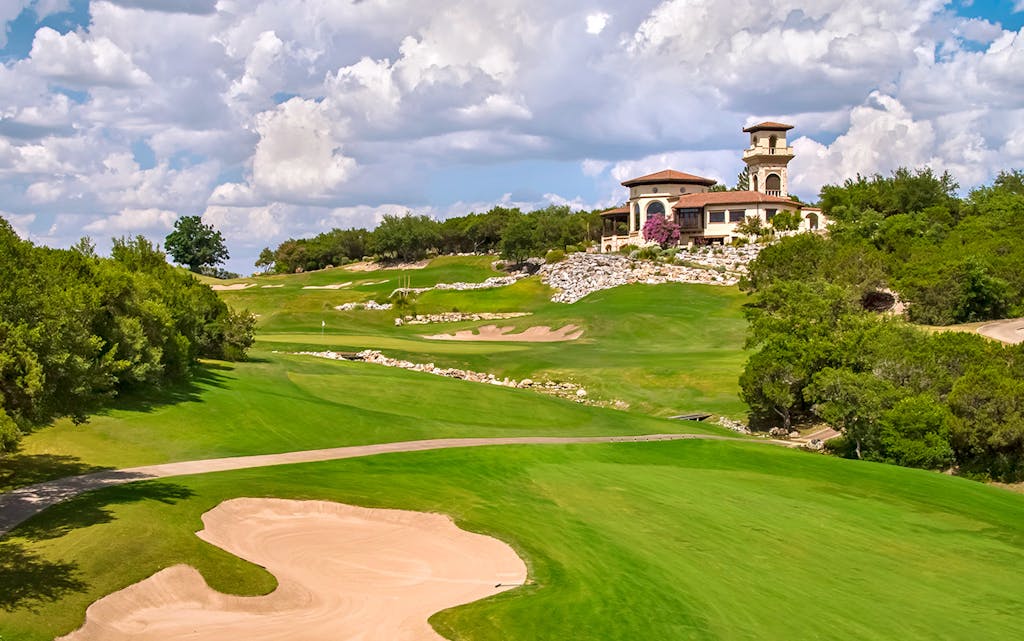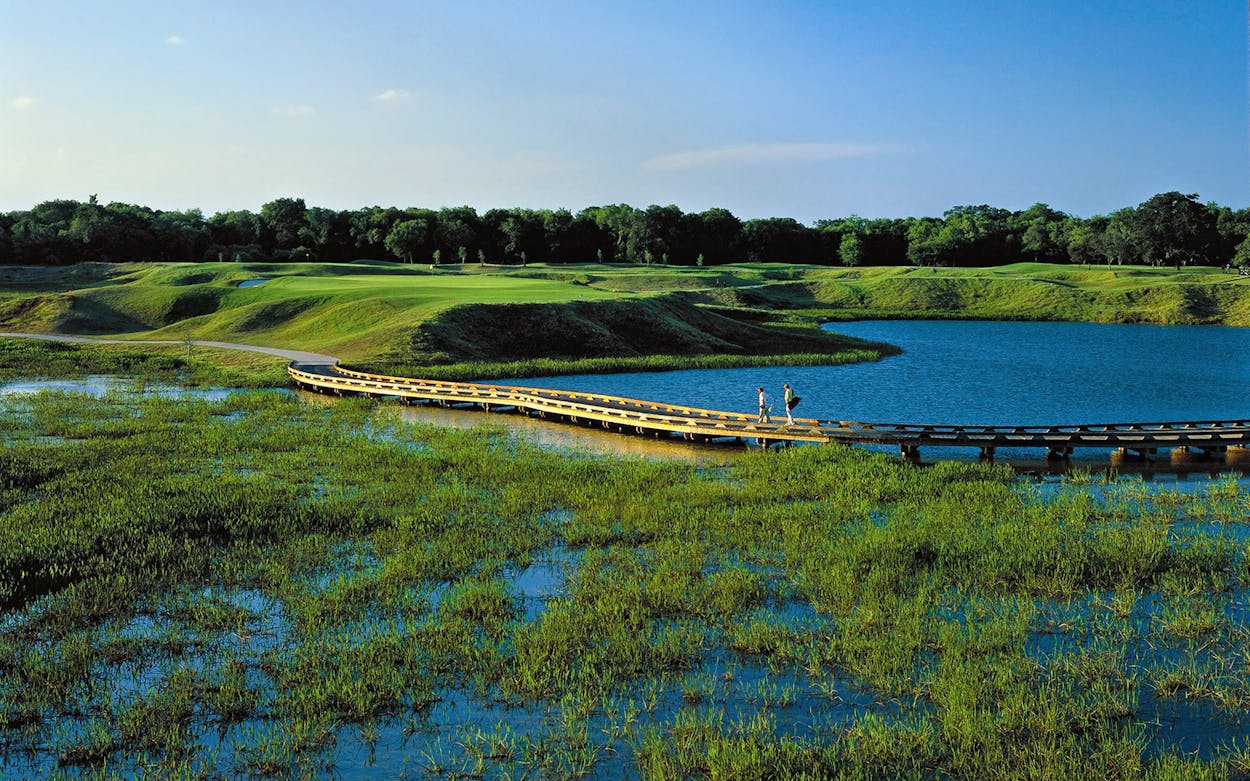Featured in the San Antonio City Guide
Discover the best things to eat, drink, and do in San Antonio with our expertly curated city guides. Explore the San Antonio City Guide
It was right around the turn of the twentieth century that Texas discovered oil—and golf. The gushing wealth created by the former helped spread the “Royal and Ancient Game,” as the state’s golf association described it in its founding 1906 mission statement. What began in the private, linen-suited confines of country clubs in Beaumont, Dallas, Houston, San Antonio, and Waco, has since grown to more than nine hundred courses, many of them open to the public, and many of those regarded among the best in the country. This list of nine represent the best of public golf across Texas. These courses are beautiful representatives of their respective regions, challenging for experienced players, not too daunting for beginners, and all at a great value. For new arrivals to Texas or to golf, and for experienced golfers seeking a fresh adventure, allow us to suggest some of our favorite courses around the state.
BlackHorse Golf Club
Cypress
This 36-hole course is wedged inside the BlackHorse Ranch community, about 35 minutes northwest of downtown Houston. The ample homes that occasionally appear along the fairways give it a country-club feel, as do the steep greens fees for prime tee times. But you get your money’s worth at this beautiful Jacobsen-and-Hardy-designed course that’s an homage to the region’s wetlands. Even better, the choice of six tee boxes makes it accessible to even the humblest duffer.
Start with the more-forgiving North Course. Most of the holes are fairly straightforward. The course opens and closes with broad, rippling fairways that are forgiving, but only up to a point: the long, wispy rough can devour wayward balls.
The South Course makes up for its shorter length—7,191 yards from the tips compared to the North’s 7,301—with a more-demanding layout. Water is a constant companion: seven holes include water features running along most or all of their respective fairways, and a winding creek occasionally comes into play. The sixteenth and seventeenth holes are especially memorable. The former, a short par four, dares big hitters to drive over a beautiful marsh, and the following par three is effectively an island—a wooden bridge just above the waterline takes you from tee box to green. The spectacular wetland landscape provides more than enough consolation for any splashed shots.
The pro shop is well stocked, and Roper’s Grill offers comfortable indoor and outdoor seating where you can enjoy the Big Jake cheeseburger (named after the course designer), or a variety of sandwiches and generously portioned salads, along with beer, cocktails, or wine. —Josh Alvarez
Greens fees: $49 to $145. Fees include practice balls and golf cart.

Memorial Park Golf Course
Houston
Bayou City golfers should count themselves lucky, if not spoiled. It’s rare to have a municipal course that’s fun, meticulously maintained, conveniently located—fewer than six miles west of downtown—and affordable. (Non-Houston residents, by comparison, must surrender their wallets to play.) Don’t bother with the $16 cart fee; this course offers an easy, enjoyable walk, and regular rainfall often means you would have to confine the cart to the paths.
Renowned designer Tom Doak teamed up with four-time major-tournament winner Brooks Koepka to renovate the 85-year-old course, which reopened in 2019. It’s now one of the country’s few PGA-certified munis, and hosts the Houston Open. Mere mortals need not fear: while playing from the tips stretches the course to a whopping 7,432 yards, one tee box down reduces it to a manageable 6,553 yards that are appealing to both scratch golfer and hack alike.
Those who fear the sand will rejoice at seeing fewer than twenty bunkers during the round, but in exchange, players must carefully navigate grass hollows, deep ravines, and thick Bermuda grass that clutches balls when they miss the fairway. Make use of the double-decker driving range to get your iron distances nailed down, because the greens can be unkind to shots that might be serviceable elsewhere. A prime example is the par three number seven, which slopes right to left toward a bunker and front to back toward a ravine. A precise, soft shot to the front allows the ball to release and stop before trouble. After the round, head over to the Becks Prime located on-site and treat yourself to the Bill’s Burger or the bacon cheeseburger, which Texas Monthly ranked a top-ten burger in the state. —Josh Alvarez
Greens fees: $15 to $140.
Brackenridge Park
San Antonio
“Brack,” as it’s lovingly known to locals, is regularly listed among the best public courses in the U.S., and for good reason. It’s a treasure, both for its rich history and the challenge it offers at an attractive price. Host of the Texas Open for many decades, the course was designed by the famed architect A. W. Tillinghast, whose resume includes such U.S. Open venues as Baltusrol and Winged Foot. Located just two miles north of the Alamo, Brackenridge opened in 1916 in a sparsely inhabited area where, according to a plaque, construction workers were menaced by “wolves, bears and other critters then native to the area.”
Measuring just 6,200 yards, the course plays longer, thanks to strategic placement of bunkers, trees, doglegs, ponds, and creeks. Many of the greens are narrow, elevated, and guarded by traps, including at the signature eighth, a lovely and wicked 188-yard par three. The greens sometimes suffer from extensive traffic, especially during dry periods. They’re best in the fall, when many San Antonians are drawn away from the links by football and hunting.
The pro shop offers a full range of ammo and armor, plus sandwiches and beer. Golfers can warm up at the Polo Field Golf Center’s driving range just a mile to the north. Many local golfers buy a membership that offers discounts on the city’s eight courses, including Brack. —Dan Goodgame
Greens fees: $24.50 to $62.

The Palmer Course at La Cantera
San Antonio
One of the most challenging and scenic golf properties in the San Antonio area, the Palmer is consistently ranked as one of the best resort courses in the U.S. Located twenty miles northwest of downtown, it sprawls along a hilly rim that overlooks much of the city. The course features dramatic elevation changes, which pose a special challenge when the wind is up. There are admirably few blind shots—at least if you stay in the fairway, which you need to do here. The rough can be punitive during wet spells or when it’s mowed taller before tournaments. On one such day, my foursome lost a half dozen balls on shots just a couple of yards off the fairway. The greens here are consistently true and are faster than most in the area.
Opened in 2001, the course was designed by the late, great Arnold Palmer, and measures about 6,900 yards from the tips. Beneath its many hills are streams and ponds, some fed by handsome man-made waterfalls, including on the signature fourth and eighteenth holes.
A driving range is available on site, as is a well-stocked pro shop and a handsome full-service restaurant and bar with commanding views of the course. Two great times to visit are in late October and early March, when pulses of monarch butterflies often migrate through the Palmer course on their way to and from their wintering grounds in Mexico. —Dan Goodgame
Greens fees: $59 to $159.
Grapevine Golf Course
Grapevine
In a state with so many fine, and even historic, parkland municipal courses, Grapevine stands out. One reason is that the great Byron Nelson influenced its design. Another is that the 27-hole property sits astride Grapevine Lake, giving the place an aura of intimacy and tranquility, most notably on the Pecan nine, where some holes play under and along the lake’s dam. Grapevine’s holes wander in every direction, and each is unique. A round here is a pleasant expedition, full of surprises and delight.
Grapevine represents, for the most part, a gentle test. That is not to say it’s easy. But it is, in the best sense, simple and sensible. Everything fits. Take the par-four fifth hole on the Pecan nine: 405 yards from an elevated tee, moving right to left toward a vaguely reverse-Redan green. It’s scenic, strategic, and, if you fancy, heroic. And, as on a handful of other holes on the Pecan and Mockingbird nines, you feel that you’re all alone with an alley of oaks. The affordability of the course is a bonus. —Kevin D. Robbins
Greens fees: $19 to $43.

The Rawls Course
Lubbock
If a mark of an outstanding golf course is its relationship and fidelity to its elements, The Rawls Course on the Llano Estacado just might be the most Texan course in the state. Designed by Tom Doak and opened in 2003, the acclaimed home course of the Texas Tech golf teams confronts players with two prominent features of northwest Texas: level land and a firing wind.
Doak rearranged more than 1.3 million cubic yards of topsoil to dimple the space with endless bumps and ripples. Tall, wispy grasses thrive in the rough between generous fairways, helping to define them amid the flat landscape. The result is a vexing and invigorating golf experience that summons the seaside links of Scotland. The wind that typically scrapes the High Plains can ratchet up the difficulty of keeping balls in position at Rawls. Low, running shots are the ticket here. The few Afghan pines on the course provide little shade or protection from the wind. There are just enough of them to serve as shot targets. Use them prudently to avoid the course’s rough and its 97 craggy bunkers.
The fourteenth hole, a 506-yard par-four, features a yawning fairway with a deep bunker standing sentry inside the left-to-right bend in the landing zone for tee shots. The approach plays slightly uphill to the most compelling green on Rawls (which is saying something, because they’re all inspiring). The front of the putting surface falls left into a hollow. A modest saddleback in the middle rises to a narrow plateau at the back, with two gaping bunkers on the left, and a generous bailout area on the right. Setting up a birdie putt here of any length is an achievement. And for most golfers, so is a bogey. —Kevin D. Robbins
Greens fees: $39 to $91.
Rockwood Golf Course
Fort Worth
In 1933, John Bredemus, the mystical, Princeton-educated math professor turned course architect credited with the creation of Fort Worth’s Colonial Country Club, also fashioned eighteen holes along the West Fork of the Trinity River. That course, Rockwood, just five miles north of Colonial, served for decades as a decent municipal for those without the wherewithal to join a private club.
Then, in 2015, the city of Fort Worth paid Colligan Golf Design, which had restored the Brackenridge Park course in San Antonio, more than $5 million to revive Rockwood. Better money was never spent. Rockwood reopened in 2017. Everything was new: tees, greens, fairways, bunkers, and drainage. Yet the new design felt respectful of the old one.
A walk on Rockwood reminds us that an American municipal golf course from the 1930s can use modern technology—improved irrigation, better agronomy, finer sand—and still pay proper homage to its roots. While the bones of the original Rockwood remain strong, the Colligan restoration sharpened subtle play angles, whittled interesting landforms into the broad Rockwood fairways and planted new bunkers in strategic locations.
The tee of the lovely par-three eighth hole takes you to one of the highest points on the property. From there, you see downtown Fort Worth—and the 142 yards from the back tee to a massive green in the shape of an amorphous arrowhead, with a spacious false front just beyond a bunker that looks a lot closer to the green than it really is. The shortest hole at Rockwood, framed beautifully by its three balanced bunkers and two lone trees, is an ode to a time when length wasn’t all that mattered. (Pro tip: don’t leave it short.)
Rockwood is exactly what a classic municipal golf course should be: engaging, modest, seductive, and just plain fun. —Kevin D. Robbins
Greens fees: $11 to $45.
Falconhead Golf Club
Austin
Located on Austin’s fast-growing western edge, just half an hour from downtown, this course offers a challenging but fair Hill Country golf experience. Designed by architects at the PGA Tour Design Center, it takes advantage of the varying elevations found across the area’s natural rolling landscape. Note that there are five sets of tees that can stretch the course to 7,181 yards or shrink it to 5,170, affording a fun experience for players of most all levels.
The second hole, a par four, is ranked the toughest on the course, with its downhill/uphill layout. The front nine closes with a trio of fine holes: a par four that is drivable for those who can hit it long and straight, a scenic par three that features a tee shot to a cantilevered green that is slightly elevated and protected by a creek on its right side (pro tip: err to the left), and a long par five that climbs (and climbs and climbs), requiring a blind approach shot to a green that runs away from the fairway. The fun continues on the back nine.
Arrive early to take advantage of Falconhead’s practice facility, which includes a driving range, pitching area, and putting green. One row of practice mats is set beneath a shady canopy, and the range offers Toptracer mobile capabilities, so be sure to download the app. After your round, take advantage of Talon’s Bar and Grill, which features a lovely covered patio exposed to refreshing Hill Country breezes. —David Courtney
Greens fees: $39 to $89.
Vaaler Creek Golf Club
Blanco
With beautiful vistas; meandering creeks; and winding fairways lined with plentiful live oak, cedar, and mesquite trees, Vaaler Creek epitomizes the best of Hill Country golf. The full eighteen-hole course opened in 2009, just six miles southeast of Blanco and about an hour’s drive from Austin and San Antonio. It serves as the centerpiece of the 1,100-acre Rockin’ J Ranch residential development, but much of the course rests amid secluded natural beauty with nary a home in sight—or in danger of errant shots.
Named for Jack Vaaler (an Army buddy of the development’s owner and a recognizable name in the San Antonio golf community), the course features well-kept MiniVerde greens, with Bermuda 419 and TifSport grasses throughout. The two nines form a figure eight laid out over gently rolling terrain that formerly served as ranchland. The clubhouse, small but functional, is located in a renovated 1860s ranch house—with a large added deck that is shaded by ancient oaks.
Vaaler presents just enough bunkering and water to keep any player’s attention, but even from the back tees, which stretch the course to 6,864 yards, Vaaler offers a pleasant round for most skill levels. The signature eighteenth is a par four featuring a severe dogleg that descends leftward down to a large pond. It leaves the golfer with a demanding shot over the water to a green that is protected on the backside by a large bunker. Here and on others of the greens, distance control is key. —David Courtney
Greens fees: $18 to $79.
- More About:
- Sports
- Golf
- San Antonio
- Lubbock
- Houston
- Fort Worth
- Dallas
- Austin






